
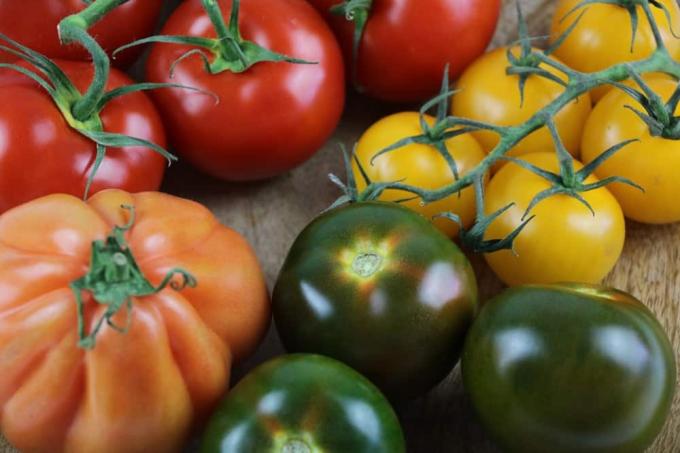
Table of contents
- Recommended varieties for the balcony
- cocktail tomatoes
- bush tomatoes
- Preculture in the house
- The right planter
- Plant
- site conditions
- when outside
- care claims
- Pour
- Fertilize
- max out
- Harvest ripe and unripe tomatoes
- Conclusion
Fruits from our own harvest cannot be compared with those from the supermarket. They are more aromatic and fruity and come in different shapes and colors. For cultivation on the balcony at home, you can grow your own plants from seeds or buy ready-made young plants in gardening shops. There are no special varieties for growing on the balcony, but there are varieties that are particularly well suited to this type of cultivation.
Recommended varieties for the balcony
Tomato varieties differ not only in shape and color, but also in growth habit. You can choose between bush, stick and cocktail tomatoes. The latter are used particularly often for growing tomatoes on the balcony. The variety of varieties is huge, so that there is something for every taste. If there is enough space and for a greater variety, the cultivation of different varieties is an option. Some varieties are particularly suitable for growing on the balcony:
cocktail tomatoes
Angora super sweet
This medium early ripening cocktail tomato has 3 - 6 cm small, extremely aromatic red fruits. They are sweet, mild and juicy but not floury. The slightly downy hairiness of the fruit is unusual. Their growth height is between 120 and 250 cm.
Black Cherry
The fruits of this early-ripening tomato have a violet to dark brown color when ripe. They are bursting, juicy and sweet in taste. The growth height is a maximum of 200 cm.
Black Zebra Cherry
The special thing about 'Black Zebra Cherry' is the dark red basic color with the emerald green, irregular stripes. The fruits are round, firm, 2.0 - 2.5 cm in size, with a spicy, sweet note. The growth height in the pot is 120 - 140 cm. Harvest time begins around mid-August.
Cuban Yellow Grape
This high-yielding variety is a very hardy wild tomato with small, yellow, egg-shaped fruits weighing up to 20 g. The taste is sweet and aromatic and the growth height in the pot is a maximum of 250 cm.
bush tomatoes
primabelle
The bush tomato 'Primabell' is a very compact, early-ripening and high-yielding pot tomato with round, intense red, approx. 30 g heavy and very aromatic fruits. With a size of 30 - 40 cm, this dwarf tomato remains very small.
balcony star
The 'Balkonstar' variety is also predestined for cultivation as a balcony tomato. It only grows to a height of 60 cm and produces an abundance of deep red, round fruits that are ready for harvest from August. They are medium sized, bursting with a slightly lemony aroma.
Tumbling 'Tom Red'
'Tumbling Tom Red' has a hanging habit and is therefore very suitable for hanging baskets. The round, red, 4 - 6 cm small and very juicy fruits have a particularly sweet aroma. Harvest time is from July to September.
RedRobin
The compact and high-yielding bush tomato 'Red Robin' is only approx. 30 cm tall and develops round, red, sweet-aromatic fruits. Harvest time is from July to October.
Tomato 'Green Zebra'
What is special about this tomato is the green-yellow striped color of the fully ripe fruit. Its aroma is intensely spicy, fresh and fruity with a fine acidity. From the end of July can be harvested. The plants grow up to 125 cm high.
Tip:
If you only have a very small balcony, it is best to opt for cocktail tomatoes, which remain comparatively low and are very productive. So-called bottle tomatoes, which can grow up to 500 cm high, are completely unsuitable for growing in buckets.
Preculture in the house

For growing tomatoes on the balcony you can buy ready-made young plants or grow them yourself. Corresponding seeds are available in every garden shop, hardware store or online. You need commercially available mini greenhouses or use small flower pots that you cover with translucent foil. The best time to sow is from the end of February.
- First let the seeds soak in warm water for a few hours
- Then spread the seeds on a nutrient-poor sowing substrate
- Cover about 0.5 cm with soil
- Moisten substrate and attach cover
- Put the whole thing in a bright and warm place
- Germination temperatures between 20 and 24 degrees are optimal
- Remove cover when seedlings have at least two pairs of leaves
- From a size of approx. 10 cm into small pots
In order to prevent the plants from wilting, they are now kept a little cooler but still bright without exposing them to the blazing sun. Now they must be neither too dry nor too wet. They are now growing relatively quickly. Before they are allowed outside on the balcony, they must be repotted in sufficiently large planters.
The right planter
The larger the planter, the better it is for the plants. The material is irrelevant. So not only pots and tubs are suitable, depending on the tomato variety, hanging baskets or so-called crow bags are also suitable. Compared to conventional tubs, plant bags have the advantage that they are already filled with high-quality soil, which provides the plants with all the important nutrients for about 6 weeks.
The planting bag is practically the planter. The plants are planted directly into pre-made openings. Evaporation is significantly lower than in buckets. The bags can be placed on the ground and planted directly. Plant 1-2 seedlings per sack. Decorative hanging baskets are suitable for small and hanging tomato varieties, such as B. flat-bush Thumbling varieties.
Planting in buckets is still the most common. They should have a capacity of at least 10 liters. With two plants per pot, it should be a good 40 liters and planting distances of 60 - 80 cm should be maintained. In addition, ensure good drainage.
Tip:
For varieties that grow very large, it is advisable to cultivate them with two to three shoots. This has the advantage that the growth is spread over several shoots and the plants remain significantly lower with the same yields.
Plant
- Before planting a drainage layer in the planter
- Coarse gravel or shards of pottery are suitable
- Plant tomato plants as deep as possible
- Ideally down to the bottom edge of the leaf
- Then press down and water the soil
- Use support rods for stabilization
- Plants could snap under the weight of the fruit

Planting deep has the advantage that more roots form on the lower part of the stem and the plants can thus supply themselves better with water and nutrients. Planting basil or nasturtium between the tomato plants can enhance the aroma of the tomatoes and minimize evaporation.
Tip:
From a certain plant size, it is advisable to remove the lowest, ground-level leaves to protect them from splashing water. Otherwise there is a risk of brown rot.
site conditions
Tomatoes generally prefer warm, dry locations that are protected from wind and rain and have as much sun as possible. As a result, balconies with a southern or southwestern orientation are best suited, as this is where the light output is highest. Heat is not a problem for these plants as long as they are adequately watered.
The situation is different with wetness from above or Rain out, he doesn't get tomato plants at all. Wet leaves promote the development of fungal diseases such as brown rot, which quickly spread through the plant and fruit. The plants are preferably placed under a canopy or in a commercial tomato house.
Basically, tomatoes grow in any permeable, fresh and nutrient-rich potting soil. The permeability can be improved by mixing in some fine gravel or expanded clay. There should not be too many coarse parts, so that the substrate does not lose its stability.
when outside
The tomato plants can go out on the balcony between the middle and the end of May. No more night frosts should be expected. However, you should give the plants a short acclimatization phase and slowly get them used to the sun. Otherwise, the sensitive leaves will get sunburned very quickly. It is best to put them outside for a few days at first only by the hour or only during the day. Later, when there is no longer any danger of frost, they can remain outside entirely.
care claims
Even if you don't have a garden, you don't have to do without homegrown vegetables. Tomatoes in particular can also be grown on a small balcony. In addition to the right location, needs-based care is also important.
Pour
Tomatoes need regular watering, they are extremely thirsty. It is better to water regularly than infrequently and intensively. Drought can cause the fruit to crack and should be avoided. However, tomatoes do not want to stand in water all the time. When watering, make sure to only water from below and never over the leaves. The best time to do this is early in the morning or in the evening. A layer of mulch ensures that the substrate does not dry out as quickly.
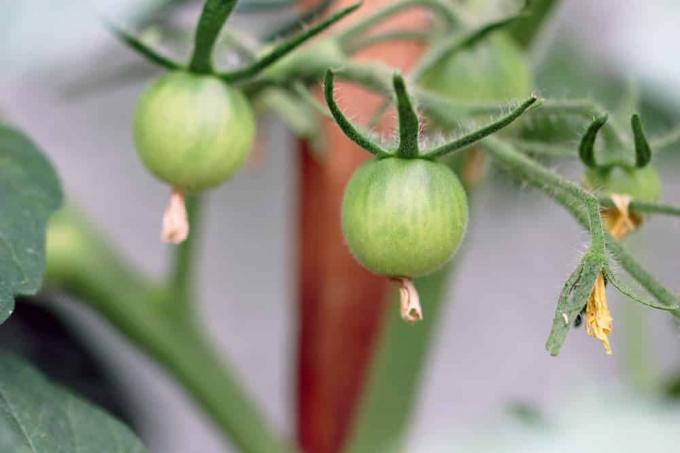
Fertilize
Tomatoes are among the heavy consumers and require continuous fertilizer application. Accordingly, you can already work a portion of horn shavings or compost into the soil when planting. As soon as the tomato plants bloom and develop the first fruits, the nutrient requirement is particularly high. Special tomato fertilizers are available on the market that contain all the important nutrients and are tailored to the needs of these plants. The dosage should be based on the specifications of the respective manufacturer. Or you work some horn shavings superficially into the moist soil about every six weeks.
max out
Opinions differ when it comes to pinching tomato plants. While some recommend squeezing, others advise against it. Pruning is about removing all those shoots that are growing out of the leaf axils. Since new so-called miserly instincts are constantly developing, the whole thing has to be repeated several times throughout the culture. Pinching out is recommended, especially for single-shoot varieties. In the case of multi-shoots such as e.g. B. It is better to avoid bush tomatoes and just let them grow. Squeezing has both advantages and disadvantages.
Advantages
- Ausgeizen makes sense if you want to harvest larger, but fewer fruits
- When space is limited
- Pinched plants are better aerated
- This can counteract the spread of fungal diseases
- Removed shoots can be left on the ground as a kind of mulch
- In this way, they provide the plants with an extra portion of fertilizer
Disadvantages
- Removing the stinging shoots creates open wounds
- This favors the penetration of pathogens
- Without pinching, the plants grow very compact and lose stability
- Removing the stinging shoots is a regular maintenance effort
- It is necessary about once a week
- Inadvertently, fruit shoots can also be cut off
- That reduces the harvest
Tip:
Pinch off fresh stinging shoots with your fingers and carefully cut them out. Slightly older ones are usually stronger and stronger, so they can be easily broken out.
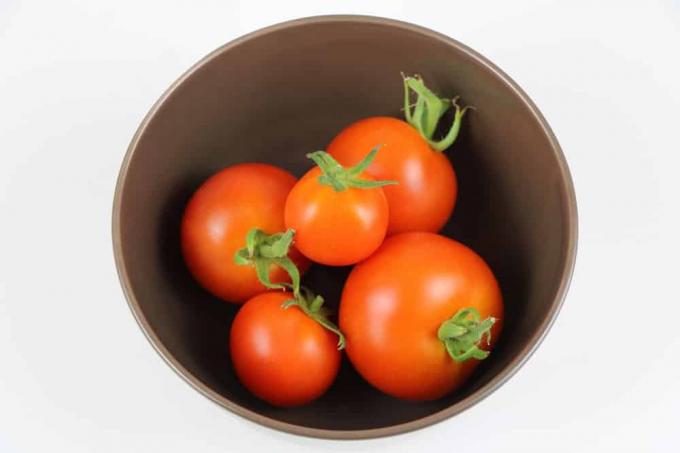
Harvest ripe and unripe tomatoes
Between July and October the time has finally come, the aromatic fruits can be harvested. Fully ripe fruits of red varieties are completely colored. The fully ripe multicolored, yellow, orange or green varieties can be recognized by the fact that the skin gives slightly under pressure. Another indication of ripe tomatoes is the predetermined breaking point on the stalk, where the fruit can be easily snapped off.
There are special green varieties that retain their green color even when fully ripe and can be eaten without any problems. All others are only green when unripe and therefore not edible. Depending on the weather, it can happen that the first frost threatens before all the fruits are ripe, or they simply haven't gotten enough sunlight. Then they don't have to be disposed of under any circumstances, but you can harvest them as normal and let them ripen in a dark and cool place. However, they do not taste as good as sun-ripened tomatoes.
Conclusion
Growing tomatoes on the balcony is a good and above all tasty alternative to tomatoes from the supermarket. The effort involved is relatively small. You should pay particular attention to the right choice of variety, a sunny location protected from rain and an optimal supply of nutrients. Then nothing stands in the way of a rich harvest on your own balcony.
 garden editorial
garden editorial I write about everything that interests me in my garden.
Learn more about tomatoes
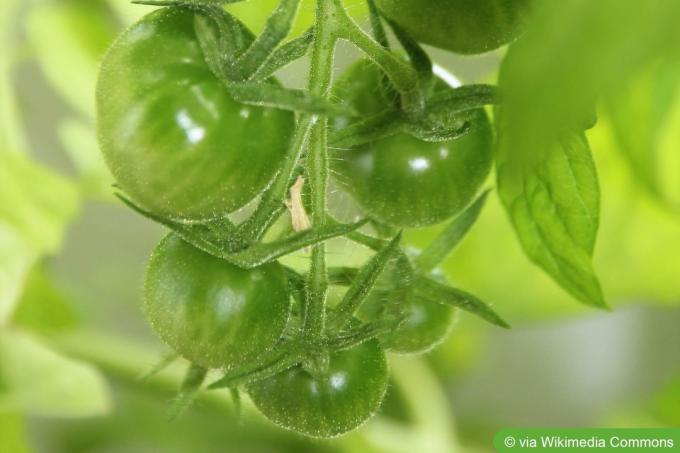
Mexican Honey Tomato: Taste & Cultivation
With the "Mexican honey tomato", hobby gardeners can bring a particularly sweet tomato variety into their garden. Due to its low acidity, it is one of the most popular sweet tomatoes and at the same time very easy to care for.
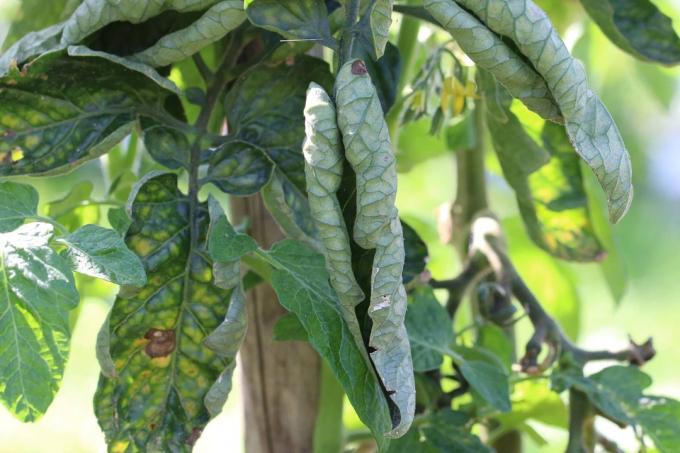
Tomato leaves curl: what to do?
There are many causes of curled leaves on tomato plants. Some are harmless, others can ruin crops. So waiting is not an option. Like a detective, you must search for clues. And then, if feasible, tailor-made countermeasures. Here's what to do when tomato leaves curl.
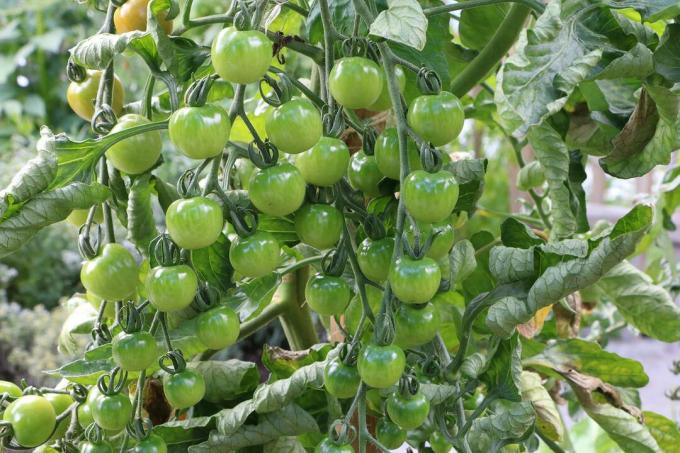
Fertilize tomatoes: how often, when and with what?
Tomatoes need a consistently high amount of nutrients for the development of flowers and fruits. In addition to choosing the right fertilizer, the amount and frequency also play an important role. All essential information for an optimal dosage can be found here.
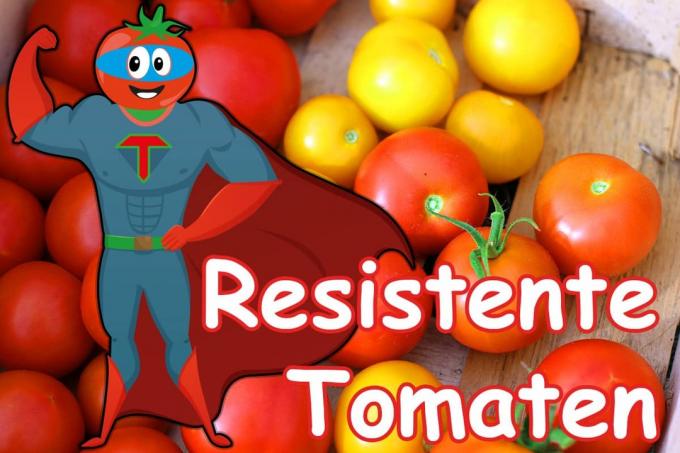
11 resistant tomato varieties defy rain and disease
Tomatoes are considered to be relatively easy to care for, but rain and numerous diseases can bother them. Fortunately, there are numerous tomato varieties that are resistant to many dreaded tomato diseases. We present the most popular specimens in this article.
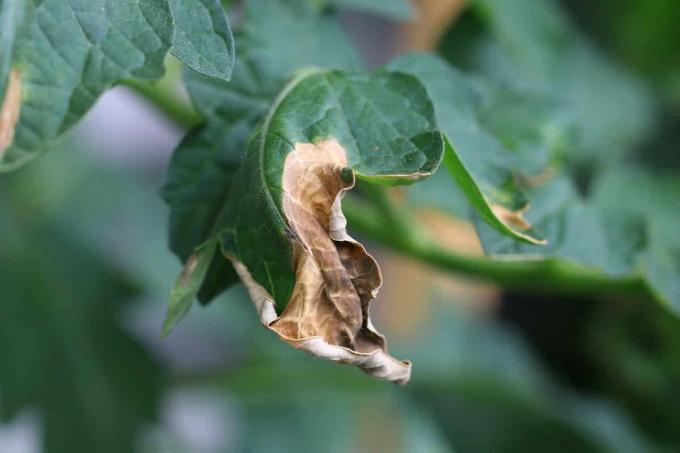
Control late blight and late blight in tomatoes
If pathogens of brown blight and late blight have settled on tomato plants, there is little hope of successful control. Home remedies and mechanical interventions only make sense in the early stages. It is all the more important that you prevent infections in a targeted manner through care measures.

How healthy are tomatoes? Information on calories, nutritional values & Co.
Snack healthy? The tomato makes it possible! Find out here why the red fruit should end up on the plate more often!

